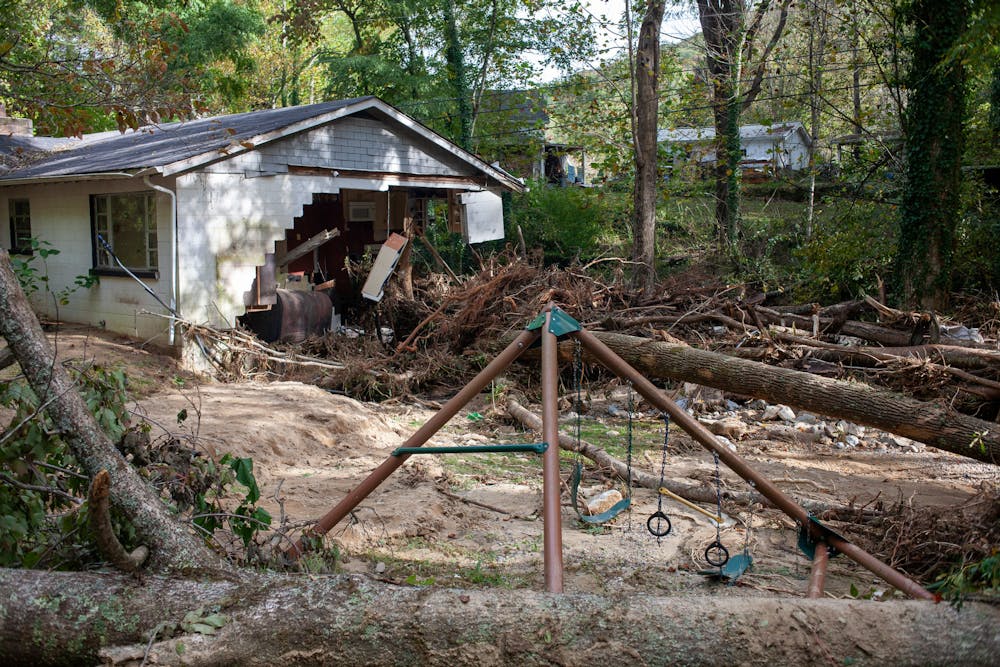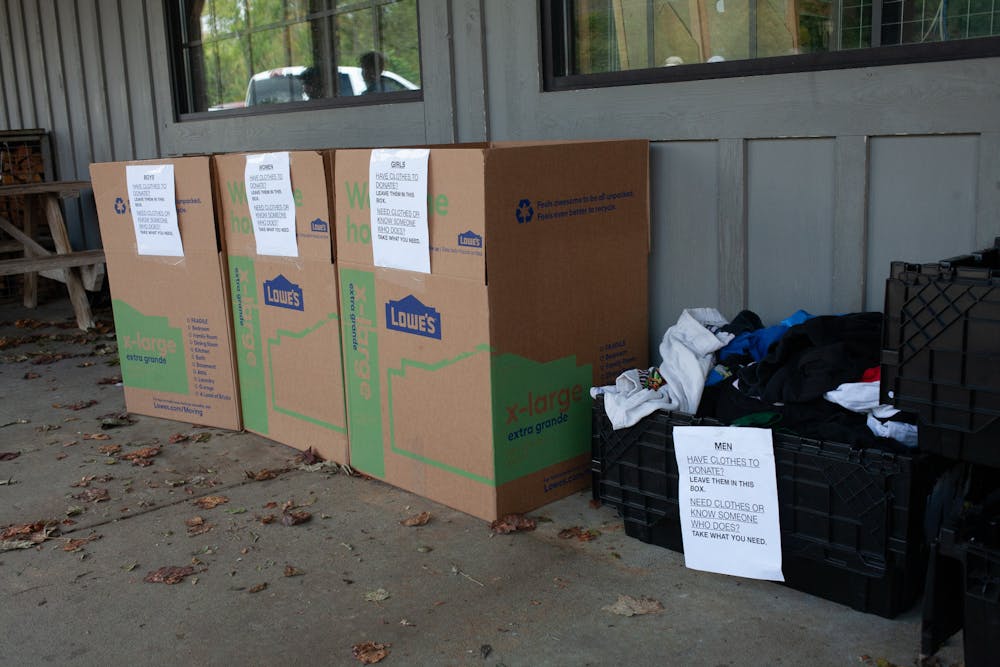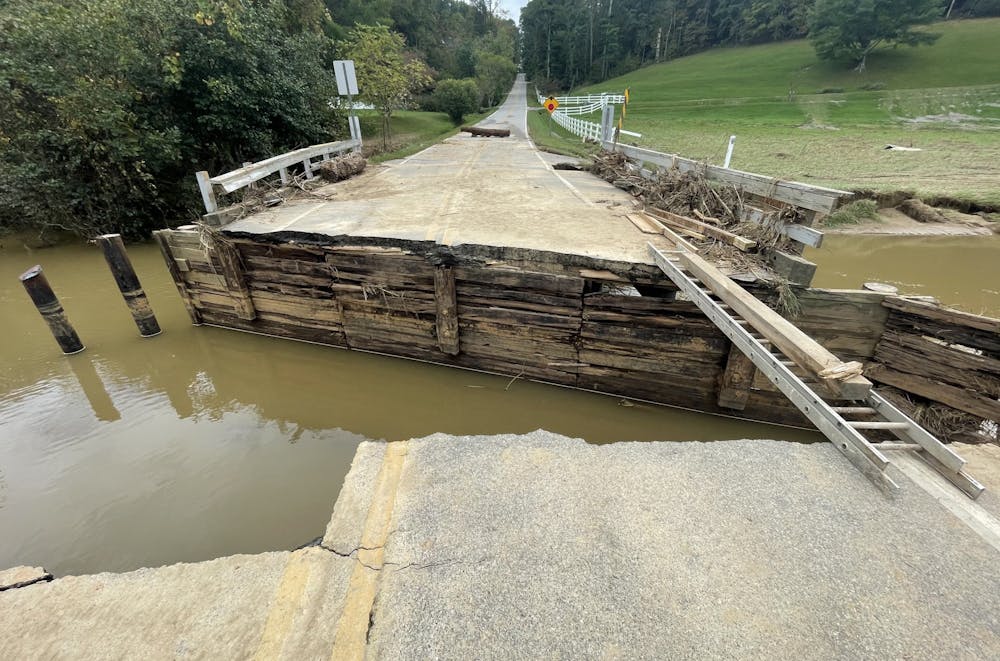Updated as of 6:04 p.m. on Oct. 4 to include video.
Fairview, North Carolina, residents Cory Weller ’20 and Shelby Sizemore were not concerned about Hurricane Helene when they got notice of a flash flood warning for their town. They didn’t fill their car with gas. They moved their basement furniture and prepped their sand bags like they usually do for storms; however, they never imagined the storm that would hit their area as hard as it did.
“We’ve gotten tropical storms before and usually by the time they hit the mountains they slow down,” Weller said. “Telling people to prep for a hurricane in the mountains, it’s like telling Florida, ‘Prep for a blizzard.’”
Hurricane Helene made landfall on the Florida Gulf coast on Sept. 26 and impacted the Southern Appalachian region the most, according to the National Weather Service. The Category 4 hurricane has raised the death toll since Oct. 3 in Buncombe County, where Asheville and Fairview are located, to 72.
The American Red Cross has opened or supported hundreds of shelters for evacuated residents and deployed almost 1,400 disaster workers to areas with emergency response vehicles, according to Kaitlyn Connelly, North Carolina Regional Communications Director of American Red Cross.

Weller said he was frustrated to hear that it took close to four days to receive resources within his town in comparison to Asheville receiving food and water Sept. 30, only a 15-minute drive away. Sizemore said the community has stepped up to become first-response volunteers by using their cars, building bridges and organizing routes to relocate residents.
“Our volunteer fire department has been out there saving people since the moment it happened,” Sizemore said. “If you own an UTV, you’re out there running people out of here. I think we get written off a lot in the South as stupid hick rednecks, but we look out for each other. We’re a self sustaining community.”
In Graham, Reverence Farms owner Suzanne Karreman has been organizing relief efforts through other local farmers and businesses to gather supplies. She said she has been using personal credit cards to pay for the resources, while having a fundraiser for those who would like to donate to help cover the costs.

During all this, she has maintained her farmstead as she said the “business of farming doesn’t stop.” Along with the farm, Karreman and her husband run the Stockholders Exchange, a mentorship program that originated from raising dairy cows.
“I’ve been on Instagram for 36 straight hours,” Karreman said in a statement to Elon News Network. “It’s amazing what you can do to work when you find people who are good hearted and have a small connection, then a larger connection and suddenly you’re in a whole network. It’s important to never burn bridges. It’s important to always build them.”
Whitley Younger was 10 hours away from her home in Lansing, North Carolina, when the storm wiped out any communication to her family that she had. A freshman at Columbia University, her plans to come home at the end of October are now under question as power is expected to come back to the area next month, according to Younger.
“It was really stressful not being able to get a hold of anyone, not being there and seeing on the weather app that it was still raining showing no signs of stopping,” Younger said. “Even on a good day, you don’t really have cell service in my town, unless you’re in the middle of town or have cell service that you can only get from Carolina West.”

Cory Weller's friend's house following Hurricane Helene. Photo courtesy of Cory Weller ‘20.
The town of Lansing’s population is recorded as 236, according to the 2022 census. Younger said she feels these small communities are not being accounted for in national coverage and those that live out-of-state think North Carolina was as prepared for the storm as Florida was.
“Lansing is really suffering from it,” Younger said. “These smaller towns that aren’t really well known, some people don’t know they’re affected. The reality is that hurricanes don’t hit western North Carolina. This is not something any of us were prepared for.”
Elon environmental science and geography professor Ryan Kirk has been researching the Appalachian area for over 20 years using geographic information systems. He said the last storm this big in western North Carolina was over 100 years ago with similar impacts, like railroads and roadways being destroyed.

Cory Weller's friend's house following Hurricane Helene. Photo courtesy of Cory Weller ‘20.
Looking over weather patterns, Kirk said there have been increases in high rainfall that are “very likely” to continue in the future. North Carolina had high intensity rainfall events, where rain falls over 2 inches in a short period of time, two weeks in a row, which softened the soil and may have contributed to landslides and trees falling. Kirk said North Carolina’s infrastructure lacks the stability to manage the amount of rainfall that accumulated.
“The biggest impact has been on our transportation or our infrastructure,” Kirk said. “Twenty to 30 inches of rain coming down in these communities, on the back of a storm that had dumped 6 inches of rain just the week before, that is what took out all the roads, power lines, electrical grid infrastructure. The destruction to the infrastructure is so widespread, and to me, that’s the heart of the issue.”
Weller said residents of mountain communities are stubborn to evacuate due to land prices, generational family histories and the community within the Appalachian region.
Sizemore, who grew up and whose family has a business in the Asheville area, said the support the inner city has for residents needs to come to the underserved communities.

She emphasized that funding from the city needs to go toward infrastructure, rather than tourism, in case another storm like this happens again. Currently, there is a Category 4 hurricane that has reached speeds up to 140 miles per hour in the Atlantic Ocean and a tropical storm approaching Florida. While it is slowing down, large swells are to be expected on the east coast. Sizemore said the acknowledgement for support brings the community up in their time of reconstruction.
“There are all these tiny towns outside of Asheville that nobody knows about that are deeply, deeply, deeply hurt by the damage Helene caused,” Sizemore said. “We are out here, too. We are trying to survive. We need help. We are a community. We have been taking care of each other for a long time and we will continue to do that.”


